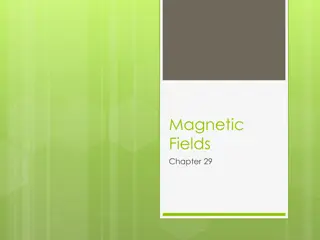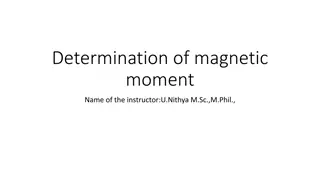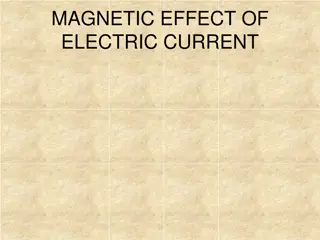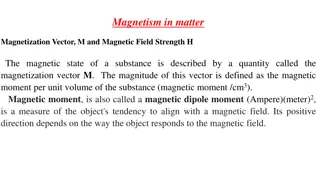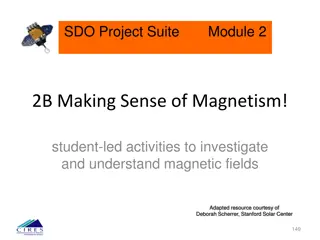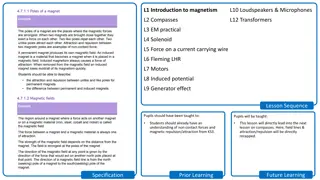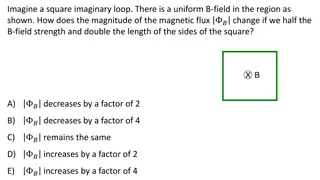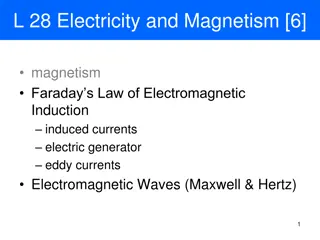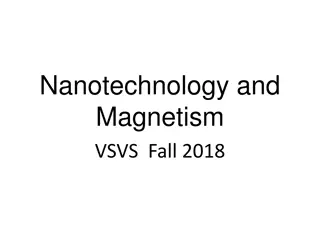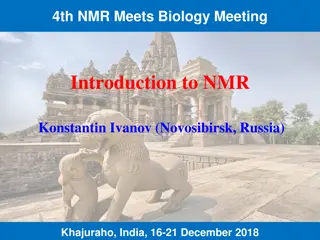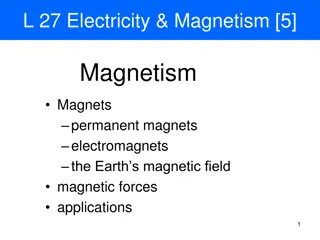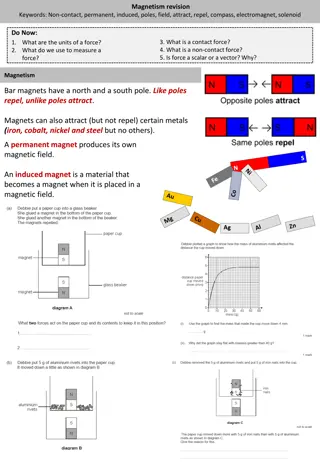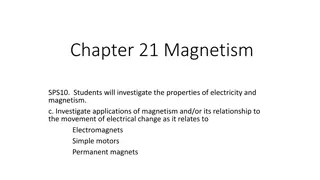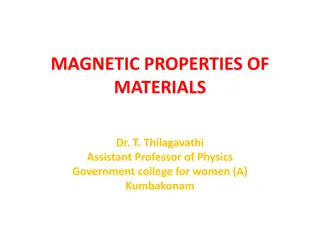Understanding Magnetic Properties and Types of Magnetism
Explore the fundamentals of magnetic properties and types of magnetism in this detailed guide. Learn about magnetic permeability, magnetic susceptibility, paramagnetism, diamagnetism, ferromagnetism, antiferromagnetism, and ferrimagnetism. Understand the magnetic moments of spinning electrons, orbital angular momentum, and the effects of magnetic fields on different substances. Delve into the characteristics and behaviors of various magnetic materials and their interactions with external fields.
Download Presentation

Please find below an Image/Link to download the presentation.
The content on the website is provided AS IS for your information and personal use only. It may not be sold, licensed, or shared on other websites without obtaining consent from the author. Download presentation by click this link. If you encounter any issues during the download, it is possible that the publisher has removed the file from their server.
E N D
Presentation Transcript
MAGNETIC PROPERTIES Name of the instructor:U.Nithya M.Sc.,M.Phil.,
The force f between two magnetic poles of strength m1 and m2 at a distance r is. f= m1m2 /qr2 q- magnetic permeability,In air and vaccum q=1. The magnetic permeability is a measure of the tendency of the lines of force to pass through yhe medium in comparision with vaccum. The magnetic field experienced by a molecule is given by. B=H+4 I B-Magnetic induction,H- field strength, I is intensity. In vaccum B=H. The intensity of magnetism induced by unit field is called the magnetic susceptibility of a substance. q=1+4 Where is specific magnetic susceptibility. The molar magnetic susceptibility is given by M= M M Molecular weight of the substance
TYPES OF MAGNETISM: I. Diamagnetism II. Paramagnetism III. Ferromagnetism IV. Antiferromagnetism V. Ferrimagnetism
Paramagnetism: The paramagnetic substances posses a permanent magnetic moment due to the presence of unpaired electrons. The orientation depends on temperature. paramagnetism is associated with the orbital angular momentum and spin. The angular momentum can have the quantised values of [l(l+1)]1/2(h/2 ). The orbital magnetic moment of the electron is given by z= ml(eh/4 m) ml- orbital angular momentum e-charge m-mass The magnetic moment if single electron is given by the Bohr magnetron. = eh/4 me
The spinning electrons have the magnetic moment. The spin angular momentum is quantised in units of[S(S+1)]1/2(h/2 ) where s=1/2. In polyatomic system the orbital motions are rigidly oriented. so the applied field has no effect and the orbital magnetic moment is inoperative. The magnetic moment is only is only due to the spin angular momentum. = 2[s(s+1)]1/2Bohr magnetrons Where s-the spin quantum number 1/2,1,3/2,2, .. The magnetic moment for n unpaired spins is given as. =[n(n+2]1/2Bohr magnetrons
DIAMAGNETISM: Diamagnetism arises due to the motion of charged electrons in the applied magnetic field. when the magnetic field is applied the induced magnetic field is changed due to the change of velocity of electrons. This fieldis opposed to the direction of the applied field leading to negative diamagnetic susceptibility. It is independent of temperature and is the same for a substance in the gas or liquid phase. The diamagnetic susceptibility is given by Xm = (-Ne2/6mc2) ri2 Where ri2is the mean squre of orbital radius. N- Avagatro number,e-electron ,m-mass,c-velocity It is the order of 10-6per gram.
Magnetic properties of free ions: The magnetic property of a substance arises due to the presence of permanent magnetic dipoles. on the application of external magnetic field the dipoles tend to align themselves along the field direction against the temperature. As a result the total angular momentum levels split symmetrically into lower and upper levels. This splitting is known as the first order zeeman effect. The grond and excited states may again be split when some characters are introduced. The orbitals are distorted before splitting. It is called second order zeeman effect.
First order zeeman effect: when a magnetic field is applied to a paramagnetic substance the magnetic dipolestend to align themselves along the field direction. Temperature has no effect on this kind of alignment. As a result the MJvalues are symmetrically split into lower and uppee levels. This kind of energy level splitting is known as first order zeeman effect. The energy levels are given by the equation. Wi=Wi + WiIH+WiIIH2 Where Wi - energy of the unperturbed state. WiIand WiII first and second order zeeman Coefficients H- applied magnetic field
The first order zerman effect for a state with J gives levels at energies. WMJ=MJg H g- lande splitting factor Bohr magnetron MJ- symmetry split into various energy levels g H energy separation between adjeacent levels
The effective magnetic moment effis given by eff= g[J(J+1)]1/2 The g value is given by the equation. g=1+J(J+1) +S(S+1)-L(L+1)/2J(J+1) where S and L are the spin and orbital angular momentum quantum numbers. L=0,J=S,and g=2.00 The effective magnetic moment equation is reduced to eff= 2[ S(S+1)]1/2 or eff= [n(n+2)]1/2 This rquations give the spin only values for the magnetic moment The energy states are thermally affected when the spin-orbit coupling constant is of the order of kT. The first order zeeman effect the magnetic susceptibility will be proportional to the Boltzmann population.
Second order zeeman effect: The second order zeeman effect is independent of temperature. It is inversely proportional to the separation of the interacting levels. When the energy level separation is large the magnetic susceptibility will be very small. The second order Zeeman effect is very important in acomlex with no spin magnetic moment Let the energy of the state J=0 is the lowest and that with J=1lies above it with an energy much higher than kT. For such systems the magnetic susceptibility arises from the secind order zeeman effect alone. The second order zeeman coefficient FJ,J+1is given by van vleck as. J FJ,J+1= WIIMJ = -(J+L+S+2)(-J+L+S)(J-L+S+1)(J+L-S+1) 2/12(J+1)2 MJ=-J
Second order zeeman effect us observed for the lanthanide elements Sm3+and Eu3+. All the otjet lanthanide ions the ground state is widely separated from the excited state and therefore the second order magnetic susceptibility is neglected. The magnetic moment of Eu3+is 3.6BM at room temoerature. according to the equation. eff= 2[J(J+1)]1/2the value must be zero.(J=0) The magnetic moment ofEu3+is not independent of temperature. At low temperature it is proportional to T.
Zeeman effect for states ~kT: When the ground and upper energy states are searated by an energy of the order of kT, the total magnetic susceptibility is fue to the girst order zeeman effect. The second order zeeman effect also contributes to the susceptibility between the adjacent states. Therefore the magnetic moment is a complicated function of temperature. Eu3+(f6) has this effect at higher temperature when the thermal population of the state J=1 is high. Sm3+(f5) also has this effect. The first order zeeman contribution is from the ground state 6H5/2and the second order zeeman contribution is from the upper state 6H7/2which lies some hundred cm- 1higher. There is thermal population of the 6H7/2state and this contributes for first and second order zeeman effects. At room temperature the magnetic moment for sm3+is 1.54BM and this varies with temperature. The energy (W3)of the upper state (J=7/2)relative to the ground state (J=5/2) is given as. WJ= [J(J+1)-|L-S|(|L-S|+1)
Zeeman effect for states <<kT Systems with energy level separation much less than kT is rare since there are no systems with very small spin-orbit coupling. but theoretically the magnetic moment can be deduced as eff= [4S(S+1)+L(L+1)]1/2 if L=0, eff= [4S(S+1)]1/2 The magnetic moment from will be for the spin only value. when L#0,the equation is used yo estimate the orbital contribution to the moment. The deviation in magnetic moment from the spin-only value occurs when the states are separated by ~kT.
Quenching of orbital angular momentum by ligand fields: The orbital angular momentum of a free metal ion is lost when it comlexes with comlexes. The orbital angular momentum is associated with the ability to rotate an orbital about an axis. This produces degenerate orbitals. The dxy(t2g) and d(x2-y2)(eg) orbitals are not degenarate and orbital angular momentum arises between them. For the existence of orbital angular momentum due to rotation the second orbital should not have an electron with yhe same spinas that of the first orbital For the t2g3and t2g6contributions the orbital angular momentum is quenched. d orbitals in these cases cannot be transformed since there is no vacant orbital and all are equivalent and degenerate with the same spin.
Quenching of orbital angular momentum for A,Eand T terms: A is the singlet,E is the doubly degenerate,and T is triply degenerate energy levels. The orbital angular momentum is zero for the A and E terms. Hence the A and E terms carry no magnetic momentum. T term possesses some orbital angular momentum. But several complexes with A and E ground state terms exhibit magnetic moments higher than the spin-only value. let the Tterm is above the ground state T term through spin-orbit coupling. Thus the A and E terms will possess some T character. The quenching and non-quenching of orbital angular momentum in a cubic ligand field for ground terms are summarized.
Magnetic properties of A and E terms: The magnetic moments of comlexes with Agand Egground terms differ apreciably from the spin-only value. An F term is split by a ligand field into the lowest A2gand upper T2gterms. The splitting factor g has a value of. g=2.00(1-4 /10Dq) For a 2A2gterm the magnetic moment is due to the first order zeeman effect. eff= (1-4 /10Dq) eff xA= (1-8 /10Dq) Aspin-only For the A1gterm there is no mixing orbitals since there is no excited term of the same multiplicity. Therefore eff= eff spin-only spin-only
For the Egterms g=2.00(1-2 /10Dq) eff= (1-2 /10Dq) eff The second order zeeman effect coefficient for the A2g term is given as. +s spin-onlyand xA= (1-4 /10Dq) xA spin-only WIIA2g= 4(2S+1) /10Dq -S The magnetic susceptibility is given as. XATIP=8N 2/10Dq For the6A1gterm of d5,d0,d10XATIP= 0
For the 1A1gterm of d6(t2g6) and for A2gterms XATIP=8N 2/10Dq For the Egterm. XATIP=4N 2/10Dq N 2= 0.261 cm-1 The magnetic behaviour of xomlexes Possessing Agand Eg ground terms are xm= C/T + N Magnetic properties of T terms : The magnetic moments for complexes with T ground terms are obtained by summing the first and second order zeeman effects. The ground state splitting by the spin-orbit coupling. The number of electrons on Pand d orbitals are same. Thus, 2T2g(d1,t12g) = 2P ( p5) (p6-1) 2T2g(d5,t52g) = 2P ( p1) 3T1g(d2,t22g) = 3P ( p4)
The g value when there is splitting of T terms is given as. g= 1-1/2A +(2+A)[S(S+1)-2]/2J(J+1) The second order zeeman effect when L=1 is given as. FJ,J+1=[(2+A)2/A]FJ,J+1free ion p term Magnetic moment due to t2gelectron delocalization: Delocalization of electrons of the t2gorbitals of the ion onto the ligand atoms take place when ever the metal and ligand orbitals mix together symmetrically to form the molecular orbitals of the complex. This reduces the orbital angular momentum of a metal ion by a factor k below those calculated. The orbital momentum is taken as 2(1-k).
t2g electron delocalization of A and E terms: A and E terms have the effects of t2gelectron delocalization. The spin orbit coupling value is reduced below the free ion value by a factor k. For A2gterms xA= xA eff= eff For Egterms xA= xA eff= eff There is also the second order zeeman effect.. spin-only(1-8k2 0/10Dq) and g=2(1-4k2 0/10Dq) spin-only(1-4k2 0/10Dq) spin-only(1-4k2 0/10Dq) and g=2(1-2k2 0/10Dq) spin-only(1-2k2 0/10Dq) For 1A1g. XA=8k2N 2/10Dq For EgXA=4k2N 2/10Dq
The total susceptibilites for the Ag terms are. XA=X Aspin only(1-8k2 0/10Dq) +8k2N 2/10Dq For Eg terms. XA=X Aspin only(1-4k2 0/10Dq) +4k2N 2/10Dq Effect of t2gelectron delocalization on magnetic moment of the 2T2g term ve, cubic symmetry v=0,highly distorted v=-10.






